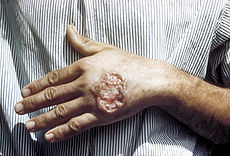Visit and Join the WeHeal Leishmaniasis Community.
For more information, see: Infoplease.com | Wikipedia

Visit and Join the WeHeal Leishmaniasis Community.
For more information, see: Infoplease.com | Wikipedia

Leishmaniasis is a disease spread by the bite of the sandfly. It is found mostly in tropical countries. There are several types of leishmaniasis, and they vary in symptoms and severity. Visceral leishmaniasis (VL, or kala azar) is the most severe; left untreated, it is always fatal. Its symptoms include fever, weight loss, anemia, and a swelling of the spleen and liver. Mucocutaneous leishmaniasis (MCL, or espundia) produces lesions that affect the nose, mouth, and throat and can destroy their mucous membranes. Cutaneous leishmaniasis (CL) produces skin ulcers, sometimes as many as 200, that cause disability and extensive scarring. Diffuse cutaneous leishmaniasis (DCL) is similar to CL, and infected people are prone to relapses. Approximately 12 million cases of leishmaniasis exist today.
Visit and Join the WeHeal Leishmaniasis Community.
For more information, see: Infoplease.com | Wikipedia
WeHeal is very grateful to our valued sources of information which include Wikipedia, WebMD, ClinicalTrials.gov, Cancer.gov, Infoplease, and the US CDC (Center for Disease Control).